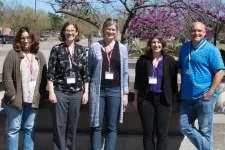(Press-News.org) BIRMINGHAM, Ala. – An ideal nanovesicle to fight cancer would have three functionalities: 1) a precision-targeting molecule to preferentially bind it to surface markers on cancer cells, 2) a strongly bound radionuclide signal that would allow a PET scan to locate the vesicles in the body, and 3) the ability to carry and release a drug treatment, such as a chemotherapy, at the cancer tumor.
It would also meet two other requirements — having a simple and facile method of manufacture, and being biocompatible and biodegradable in the body.
A University of Alabama at Birmingham team has now described a tiny polymersome that — in initial preclinical experiments — appears to meet these hurdles. Each polymersome is a hollow sphere with a thin wall, but it is the coating on the polymersome that marks a step forward.
The 60-nanometer triblock copolymer polymersomes have degradable tannic acid, or TA, adsorbed onto the surface through hydrogen bonding. That TA, in turn, is able to quickly and stably bind a monoclonal antibody-targeting molecule and zirconium radionuclide, or Zr, without the need to build specific linkers, such as chelators, say Eugenia Kharlampieva, Ph.D., and Suzanne E. Lapi, Ph.D., leaders of the UAB team. Their study is published in the journal Biomacromolecules.
“In this study, we have developed a simple approach for a chelator-free modification of the PVPON5-PDMS30-PVPON5 triblock copolymer nanovesicles, about 60 to 80 nanometers in diameter, with a layer of polyphenol that can be simultaneously used to anchor 89Zr radiotracer or other active metal ions for molecular imaging, and a HER2-targeting ligand, trastuzumab monoclonal antibody, for nanovesicle targeting to HER2-positive breast cancer cells,” said Kharlampieva, a distinguished professor in the UAB College of Arts and Sciences’ Department of Chemistry. PVPON5 is a short, five-monomer hydrophilic polymer block, and PDMS30 is a longer, 30-monomer, hydrophobic polymer block within the triblock copolymer.
Breast cancer is one of the most common cancer diseases, and global rates of death are still high. Systemic drugs or therapeutic antibodies are current therapies, but they are often associated with heart damage and dysfunction. Image-guided drug delivery to a solid tumor could allow effective drug activity with reduced drug toxicity.
“To the best of our knowledge, our work represents the first example of a chelator-free-radiolabeled polymersome capable of a long-term multiday PET imaging study in vivo,” said Lapi, director of the UAB Cyclotron Facility and a professor in the UAB Department of Radiology. “The radiolabeling approach developed herein can potentially provide stable binding of a wide spectrum of isotopes without radiometal leaching from the vesicle membrane in vivo. Notably, this approach integrates the inherent advantages of a polyphenolic polymersome membrane with the benefit of quickly anchoring breast cancer cell-targeting ligands.”
In the study, TA on the polymersome bound 89Zr4+ radionuclide through nonspecific ionic pairing, and the TA also bound the trastuzumab monoclonal antibody, or Tmab, through hydrogen bonding and ionic pairing. There was excellent retention of the 89Zr for up to seven days, as confirmed by PET scans in healthy mice.
“The noncovalent Tmab anchoring to the polymersome membrane can be highly advantageous for nanoparticle modification compared to currently developed covalent methods, as it allows easy and quick integration of a broad range of targeting proteins,” Kharlampieva said. “Given the ability of these polymersomes to encapsulate and release anticancer therapeutics, they can be further expanded as precision-targeted therapeutic carriers for advancing human health through highly effective drug-delivery strategies.”
One hour of incubating the TA-polymersomes in a solution of 89Zr-oxalate led to radiolabeling yields of 97 percent, and those yields remained consistent over one, three and seven days. The labeled polymersomes were not cytotoxic when incubated in vitro with two lines of cancer cells up to four days. Furthermore, binding of 89Zr to polymersomes with Tmab already attached also had high yields of 97 percent and stability through seven days. These binding yields are sufficiently high for clinical use, the UAB researchers say.
Next, the stable retention of the 89Zr on the TA-polymersomes was demonstrated indirectly in mice.
The biodistribution of free 89Zr radiotracer has been previously reported to localize largely in the spine and femurs of animals due to chelation of the zirconium with phosphate moieties in the bone. The UAB researchers found that, when free 89Zr was injected into mice, nearly all of it was located in the femur bones after 24 hours, as measured by a PET scan. A greatly different biodistribution was seen when 89Zr-TA-polymersomes were injected into mice. Negligible radioactivity was found in bones; instead, nearly all the radioactivity was in the spleen and liver. That location represents the known expected clearance of nanovesicles through the mononuclear phagocyte system for nanomaterials larger than 6 to 8 nanometers.
“The observed drastic difference between the biodistribution of the free 89Zr and the metal radiotracer-labeled vesicle is important, as it demonstrates an unimpeded capability of the polymeric nanocarrier to be tracked in vivo,” Lapi said.
The strong imaging contrast in the mice was retained through seven days, further evidence of tight retention of the 89Zr on the TA-polymersomes.
The ability of the 89Zr-Tmab-TA-polymersomes to target HER2-positive cancer cells was shown in vitro by differential binding of the nanovesicles to HER2-positive breast cancer cells versus HER2-negative cells. The researchers say further testing to target breast cancer tumors in animals is warranted.
Co-first authors of the study, “Direct radiolabeling of trastuzumab-targeting triblock copolymer vesicles with 89Zr for positron emission tomography imaging,” are Veronika Kozlovskaya, UAB Department of Chemistry, and Maxwell Ducharme, UAB Department of Radiology.
Other co-authors with Kharlampieva, Lapi, Kozlovskaya and Durcharme are Maksim Dolmat and James M. Omweri, UAB Department of Chemistry; and Volkan Tekin, UAB Department of Radiology.
Support came from the National Science Foundation Division of Materials Research award #2208831.
About UAB
Known for its innovative and interdisciplinary approach to education at both the graduate and undergraduate levels, the University of Alabama at Birmingham, a part of the University of Alabama System, is an internationally renowned research university and academic medical center with over $700 million in research awards annually, as well as Alabama’s largest single employer, with some 28,000 employees, and has an annual economic impact exceeding $12.1 billion on the state. The pillars of UAB’s mission include education, research, innovation and economic development, community engagement, and patient care. Learn more at www.uab.edu.
END
Easy and quick binding of targeting molecule and radiotracer to drug nanocarrier for cancer therapy
This is the first example of a chelator-free-radiolabeled polymersome capable of a long-term multiday positron emission tomography, or PET, imaging study in vivo.
2023-04-10
ELSE PRESS RELEASES FROM THIS DATE:
SPOILER ALERT: Condolences to the fans of Logan Roy patriarch of HBO’s Succession
2023-04-10
DALLAS, April 10, 2023 — The American Heart Association sends fans of the two-time Emmy Award winning best drama series “Succession” our heartfelt condolences following the sudden cardiac death that killed off main character, Logan Roy, played by Brian Cox.
(SPOILER ALERT) Those who watched last night’s episode on HBO in stunned silence, saw patriarch businessman Logan suffer a cardiac arrest while on a plane as his eldest son, Connor, celebrated his wedding. Logan’s other three children ...
Purdue receives $1 million USDA grants for sustainable agriculture projects
2023-04-10
Purdue receives $1 million USDA grants for sustainable agriculture projects
WEST LAFAYETTE, Ind. — Purdue University has received two grants of $1 million each from the U.S. Department of Agriculture’s National Institute of Food and Agriculture for five-year projects to enhance sustainable agricultural systems.
One grant is part of a $10 million project led by Michigan State University’s Brent Ross to develop more resilient food systems for coping with multiple ...
Light pollution may extend mosquitoes’ biting season
2023-04-10
COLUMBUS, Ohio – A new study’s finding that urban light pollution may disrupt the winter dormancy period for mosquitoes that transmit West Nile virus could be considered both good news and bad news.
The good news is that the disease-carrying pests may not survive the winter if their plans to fatten up are foiled. The bad news is their dormancy period, known as diapause, may simply be delayed – meaning they’re biting humans and animals longer into the fall.
“We see the highest levels ...
UH assistant professor named ‘Emerging Leader’ by offshore technology conference
2023-04-10
Xingpeng Li, an assistant professor in the Department of Electrical and Computer Engineering at the University of Houston’s Cullen College of Engineering, has been named an Emerging Leader by the 2023 Offshore Technology Conference. Of the nine honorees, Li is the only one from an institution of higher education.
The program selects young professionals with fewer than 10 years of experience in the offshore energy sector who demonstrate exceptional talents, commitment and promise as future leaders, according ...
Can alcohol-associated burn injuries impair cognitive function?
2023-04-10
The relationship between alcohol use and burn injuries is a negative one in multiple ways. Not only are about 50% of adults who sustain burn injuries intoxicated at the time of injury, suggesting that alcohol use may have contributed to the incident, but alcohol use among burn-injured patients is associated with more severe complications, delayed recovery, and increased morbidity and mortality.
“Return to work or normal life can be impaired or delayed for burn-injured patients who use alcohol,” says Elizabeth Kovacs, PhD, vice chair of research and professor of GI, trauma, and endocrine surgery ...
Those who avoided COVID-19 precautions early in the pandemic are more likely to buy firearms
2023-04-10
People who avoid COVID-19 precautions to prevent illness are more likely to purchase firearms – a pattern of behavior most common among moderate and conservative individuals, according to a Rutgers study.
The researchers surveyed a sample of 6,404 adults from three states: Minnesota, Mississippi and New Jersey. The survey was conducted in early 2021, before COVID-19 vaccines were widespread, and participants were asked about their intent to receive a COVID-19 vaccine, how often they wear masks in public, ...
Better understanding the physics of our universe part of collaborative research effort
2023-04-10
For the last six years, Indiana University researchers and collaborators from around the world have sought to answer important questions about the most basic laws of physics that govern our universe. Their experiment, the Majorana Demonstrator, has helped to push the horizons on research concerning one of the fundamental building blocks of the universe: neutrinos.
The experiment’s final report was published in Physical Review Letters in February.
Neutrinos – subatomic particles similar to an electron but that have no electric ...
Scientists create model to predict depression and anxiety using artificial intelligence and social media
2023-04-10
Researchers at the University of São Paulo (USP) in Brazil are using artificial intelligence (AI) and Twitter, one of the world’s largest social media platforms, to try to create anxiety and depression prediction models that could in future provide signs of these disorders before clinical diagnosis.
The study is reported in an article published in the journal Language Resources and Evaluation.
Construction of a database, called SetembroBR, was the first step in the study. The name is a reference to Yellow September, an annual suicide awareness and prevention campaign, and also to the fact that ...
Scientists advocate for integration of biogeography and behavioral ecology to rapidly respond to biodiversity loss
2023-04-10
An interdisciplinary team of researchers at the University of Oklahoma has published a perspective article in the journal Proceedings of the National Academy of Sciences advocating for convergent research that integrates the fields of biogeography and behavioral ecology to more rapidly respond to challenges associated with climate change and biodiversity loss.
While news about climate change fills headlines, the crisis of biodiversity loss has gotten less attention. In their article, the authors contend that “identifying solutions that prevent large-scale extinction requires addressing critical questions about biodiversity dynamics that – ...
ACC Cardio-oncology Course equips clinicians, researchers with tools to improve cardiovascular care for cancer patients
2023-04-10
The American College of Cardiology will host the annual Advancing the Cardiovascular Care of the Oncology Patient course on April 14-16, 2023, in Washington, DC. The course is intended for all members of the interprofessional care team—including cardiologists, oncologists, pharmacists and nurses—and aims to equip the global cardio-oncology community with the tools they need to improve patient care.
Ana Barac, MD, PhD, FACC, and Bonnie Ky, MD, MSCE, FACC, will serve as co-directors for the course, which ...
LAST 30 PRESS RELEASES:
Understanding the role of linear ubiquitination in T-tubule biogenesis
Researchers identify urban atmosphere as primary reservoir of microplastics
World’s oldest arrow poison – 60,000-year-old traces reveal early advanced hunting techniques
Bristol scientists discover early sponges were soft
New study uncovers how rice viruses manipulate plant defenses to protect insect vectors
NSF–DOE Vera C. Rubin Observatory spots record-breaking asteroid in pre-survey observations
Ribosomal engineering creates “super-probiotic” bacteria
This self-powered eye tracker harnesses energy from blinking and is as comfortable as everyday glasses
Adverse prenatal exposures linked to higher rates of mental health issues, brain changes in adolescents
Restoring mitochondria shows promise for treating chronic nerve pain
Nature study identifies a molecular switch that controls transitions between single-celled and multicellular forms
USU chemists' CRISPR discovery could lead to single diagnostic test for COVID, flu, RSV
Early hominins from Morocco reveal an African lineage near the root of Homo sapiens
Small chimps, big risks: What chimps show us about our own behavior
We finally know how the most common types of planets are created
Thirty-year risk of cardiovascular disease among healthy women according to clinical thresholds of lipoprotein(a)
Yoga for opioid withdrawal and autonomic regulation
Gene therapy ‘switch’ may offer non-addictive pain relief
Study shows your genes determine how fast your DNA mutates with age
Common brain parasite can infect your immune cells. Here's why that's probably OK
International experts connect infections and aging through cellular senescence
An AI–DFT integrated framework accelerates materials discovery and design
Twist to reshape, shift to transform: Bilayer structure enables multifunctional imaging
CUNY Graduate Center and its academic partners awarded more than $1M by Google.org to advance statewide AI education through the Empire AI consortium
Mount Sinai Health system receives $8.5 million NIH grant renewal to advance research on long-term outcomes in children with congenital heart disease
Researchers develop treatment for advanced prostate cancer that could eliminate severe side effects
Keck Medicine of USC names Christian Pass chief financial officer
Inflatable fabric robotic arm picks apples
MD Anderson and SOPHiA GENETICS announce strategic collaboration to accelerate AI-driven precision oncology
Oil residues can travel over 5,000 miles on ocean debris, study finds
[Press-News.org] Easy and quick binding of targeting molecule and radiotracer to drug nanocarrier for cancer therapyThis is the first example of a chelator-free-radiolabeled polymersome capable of a long-term multiday positron emission tomography, or PET, imaging study in vivo.





